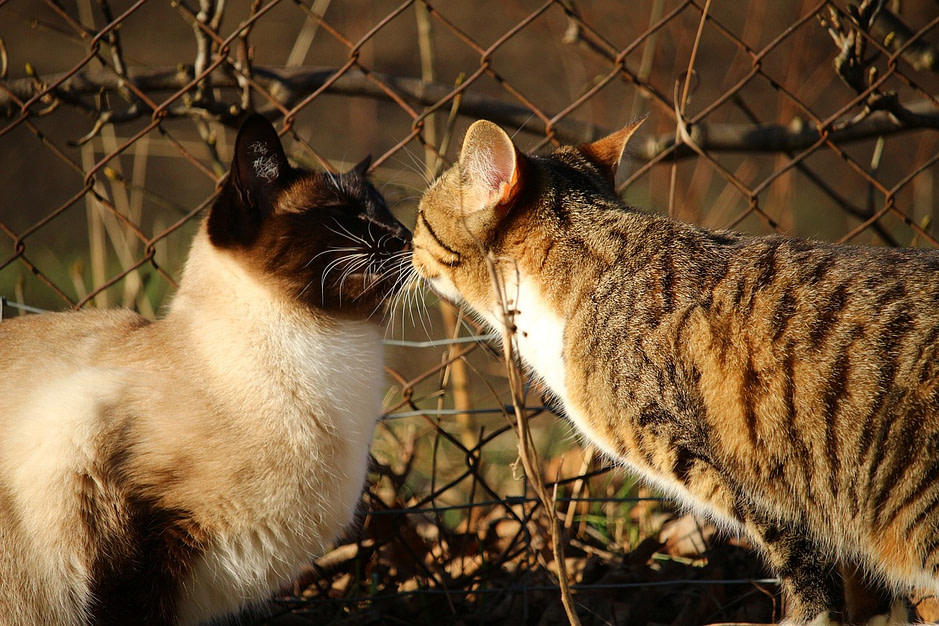A question often asked by people learning about Siamese cats is do Siamese cats get along with other cats?
When it comes to feline friendships, Siamese cats are quite the social butterflies. These outgoing and chatty kitties have a knack for getting along with other cat breeds. But introducing a Siamese cat to a new furry companion requires some careful steps.
From creating separate territories to gradually introducing them, it’s all about making their interactions positive and rewarding. And if you happen to have a jealous Siamese on your hands, fear not! There are ways to address their jealousy and foster harmonious relationships.
So, let’s dive into the fascinating world of Siamese cats and their compatibility with other feline companions.
Key Takeaways
- Siamese cats have an outgoing and sociable personality and can generally form strong bonds with other cat breeds.
- Compatible cat breeds for Siamese cats include Maine Coon, Ragdoll, Abyssinian, Persian, and Siberian.
- Introducing a new cat to a Siamese cat should be done gradually, starting with creating separate territories and allowing them to get accustomed to each other’s scent.
- Jealousy and bullying behaviors in Siamese cats can be addressed by providing extra love and attention, reassurance, and separate attention and resources for each cat.
Personality and Compatibility of Siamese Cats
Siamese cats have an outgoing and sociable personality, making them compatible with other cat breeds. Their temperament is known for being friendly and engaging, allowing them to easily get along with other feline companions. Siamese cats are highly social creatures who crave attention and affection from their owners. They are also intelligent and talkative, often communicating through their unique vocalizations.
When introducing a Siamese cat to another cat, it is important to follow proper training techniques. This includes creating separate territories for each cat initially, allowing them to become accustomed to each other’s scent before gradually introducing them in the same room. Treats and positive reinforcement should be provided during interactions to encourage positive associations.
In some cases, a Siamese cat may show signs of jealousy towards a new feline addition. This can manifest as strong affection or aggression towards the newcomer. To address this behavior, extra love and attention should be given to the Siamese cat while ensuring that the new cat has its own space and belongings. Reassurance should be provided that some things won’t change despite the presence of a new companion.
If a Siamese cat exhibits bullying behaviors towards another cat such as running ahead or chasing, it is essential to address any underlying jealousy issues. Techniques used for dealing with jealous cats can be implemented, including providing separate attention and resources for each feline.
Clear communication is crucial when addressing misbehavior or aggression in Siamese cats. Physical punishment should never be used; instead alternative methods like diversions or verbal reprimands can be employed for discipline purposes. When handling aggression between Siamese cats and other breeds, calming techniques such as providing hiding spots and ensuring access to resources can help ease tension.
It is worth noting that not all Siamese cats exhibit jealous or bullying tendencies; many are easy-going and enjoy having companionship from other felines. By understanding their sociable nature and using appropriate training techniques, Siamese cats can thrive in a multi-cat household.
Introducing a Siamese Cat to Another Cat
When introducing a new cat to your home, it is important to create a separate territory and gradually introduce them in the same room. This allows both cats to adjust and become familiar with each other’s scent before coming face-to-face.
Here are some tips for successful introduction process:
- Creating a positive environment for multiple cats:
- Provide separate litter boxes, food bowls, and sleeping areas for each cat.
- Ensure that there are plenty of hiding spots and vertical spaces for each cat to retreat to.
- Use pheromone diffusers or sprays to promote relaxation and reduce stress.
- Establishing a hierarchy among multiple cats:
- Allow the resident cat (the one already living in the home) to maintain their territory initially.
- Gradually introduce the new cat by swapping bedding or using a barrier such as a baby gate.
- Supervise interactions between the cats and intervene if any aggression occurs.
- Common challenges when introducing cats:
- Jealousy: Provide equal attention, love, and reassurance to both cats.
- Bullying: Address underlying issues, provide separate resources, and seek professional help if needed.
- Aggression: Calm down the aggressive cat, provide hiding spots, ensure access to resources, and consider slow reintroduction.
Building trust and harmony between cats takes time but is achievable with patience and proper introduction techniques. By following these tips, you can create a positive environment where your cats can coexist peacefully.
Dealing With a Jealous Siamese Cat
Dealing with a jealous Siamese cat can be challenging, but providing extra love and attention can help alleviate their feelings of jealousy. Addressing jealousy in Siamese cats is important to promote harmony between cats and build trust with a jealous Siamese.
One strategy for managing a jealous Siamese is to ensure that each cat has its own space and belongings. This helps prevent possessiveness over resources, reducing the chances of conflict. Reassurance should also be provided to the Siamese cat that some things won’t change, such as the amount of love and attention they receive.
Monitoring behavior is crucial when dealing with a jealous Siamese cat. If signs of aggression or clinginess arise towards the new cat, separate attention may need to be given to address any underlying issues. Additionally, gradually introducing the cats in a controlled manner can help them become familiar with each other’s scents and reduce tension.
Promoting trust between cats involves positive reinforcement during interactions and ensuring that both cats have access to essential resources like food, water, and litter boxes. Building trust takes time, patience, and consistency in providing equal amounts of affection to all cats involved.
Handling a Siamese Cat That Bullies the Other Cat
If your Siamese cat exhibits bullying behaviors towards another cat, it’s important to address the underlying issues and seek professional help if necessary. Bullying behavior can be detrimental to the well-being of both cats involved and can create a hostile environment in your home.
Here are some steps you can take to address this issue:
Addressing bullying behavior:
Identify the triggers for the bullying behavior and try to eliminate them.
Provide separate resources such as food bowls, litter boxes, and resting areas for each cat.
Implement positive reinforcement techniques like treats and praise when both cats interact peacefully.
Seeking professional help:
If the bullying behavior persists or escalates, consider consulting with a veterinarian or animal behaviorist who specializes in feline behavior.
They can provide guidance on how to modify the aggressive tendencies of your Siamese cat and promote positive interactions between the two cats.
Monitoring progress:
Keep a close eye on their interactions and monitor any changes in behavior.
Document any progress or setbacks that occur during the process of addressing the bullying behavior.
Misbehavior and Aggression in Siamese Cats
Misbehavior and aggressive behavior can be addressed in Siamese cats through clear communication, positive reinforcement, and providing access to resources. Siamese cats are known for their assertiveness and strong personalities, which can sometimes lead to behavioral issues. Understanding Siamese cat body language is crucial in identifying signs of distress or aggression.
When addressing misbehavior, it’s important to avoid physical punishment and instead opt for alternative methods such as diversions or verbal reprimands. Training techniques for Siamese cats should focus on positive reinforcement, rewarding good behavior rather than punishing bad behavior. Clear communication with the cat through consistent commands and cues can help establish boundaries and expectations. Providing access to resources such as scratching posts, toys, and hiding spots can also help redirect their energy and prevent destructive behaviors.
In cases of aggression towards other cats, it’s important to calm the Siamese cat down by creating a peaceful environment with plenty of hiding spots. Slow reintroduction may be necessary, allowing them to gradually get used to each other’s presence without triggering aggressive reactions. Professional help should be sought if the aggression persists.
Addressing Siamese cat aggression requires patience, understanding, and a proactive approach. By implementing these training techniques and providing a supportive environment, behavioral issues in Siamese cats can be effectively managed. Remember that not all Siamese cats exhibit aggressive tendencies; many are easy-going companions who enjoy having a friend by their side.
Popular Cat Breeds That Go Best With Siamese Cats
When considering getting a second cat, you might want to consider breeds like Birman, Abyssinian, Ragdoll, Exotic Shorthair, Maine Coon, or Siberian that are known to go well with Siamese cats. These breeds have characteristics and temperaments that complement the sociable nature of Siamese cats.
Here are some reasons why these breeds can make great companions for your Siamese cat:
Birman: Birmans have a similar playful and friendly nature as Siamese cats. They enjoy the company of other cats and can provide great companionship making them the perfect partners for this beautiful breed.
Ragdoll: Ragdoll cats are known for their calm and gentle personalities. Their laid-back nature makes them the perfect companion with the active and outgoing personality of Siamese cats.
Abyssinian: Abyssinians are a highly social breed of cat that thrive in multi-cat households. Their friendly outgoing nature and playful personality allows them to easily socialize with Siamese cats.
Exotic Shorthair: Exotic Shorthairs have a lively personality and are generally friendly towards everyone, including other cats. Their easy-going nature can help facilitate a smooth introduction with your Siamese cat.
Maine Coon: Maine Coons are intelligent and adaptable cats. They can easily adjust to different environments and get along well with other breeds, including Siamese cats.
These breed recommendations provide options for introducing a new companion to your Siamese cat while ensuring compatibility and companionship. Remember to properly introduce any new cat gradually by following proper introduction techniques to ensure a harmonious relationship between your furry friends.
Frequently Asked Questions
Siamese cats, like any other breed, can experience separation anxiety and behavioral issues if left alone for long periods. To prevent loneliness concerns, mental stimulation and hiring pet sitters are important solutions.
Siamese cats are generally sociable and can get along well with other cats. They have specific health issues such as dental problems and respiratory conditions. They require regular grooming for their short coat, exercise, and a balanced diet to maintain their overall health.
Siamese cats have an average lifespan of 12-15 years. They are outgoing and sociable, but also need alone time. While they can get along with other cats, proper introductions and monitoring are important.
Siamese cats require regular grooming to maintain their sleek coats. Grooming techniques include brushing, bathing, and nail trimming. Grooming frequency depends on the cat’s coat type and shedding season. Essential grooming tools include a brush, comb, and cat-friendly shampoo. Helpful grooming tips involve starting early, using positive reinforcement, and creating a calm environment.
So . . . Do Siamese Cats Get Along With Other Cats?
Introducing a Siamese cat to another popular breed of cat can be a delicate process that requires patience and careful steps.
It is important to create separate territories and gradually introduce them in the same room, using treats and positive reinforcement during interactions.
Jealousy in Siamese cats can manifest as strong affection or aggression, so it is crucial to give extra attention to the Siamese cat while providing the new cat with its own space and belongings.
Bullying behaviors should be addressed by addressing underlying jealousy issues, while misbehavior and aggression can be dealt with through clear communication and alternative methods.
Remember, not all Siamese cats are jealous or bullying types, so many can enjoy having a feline friend.


